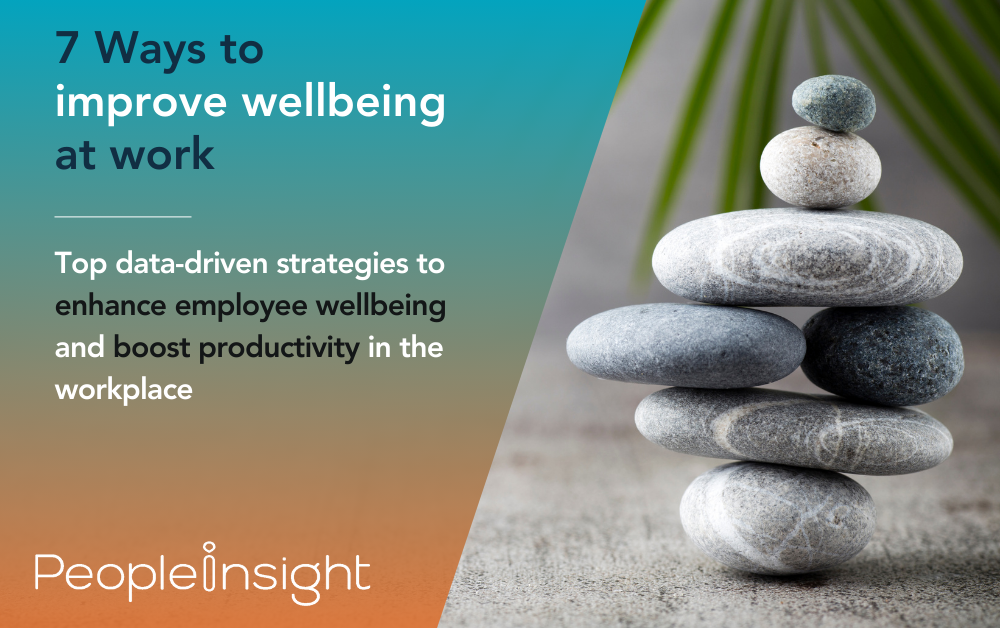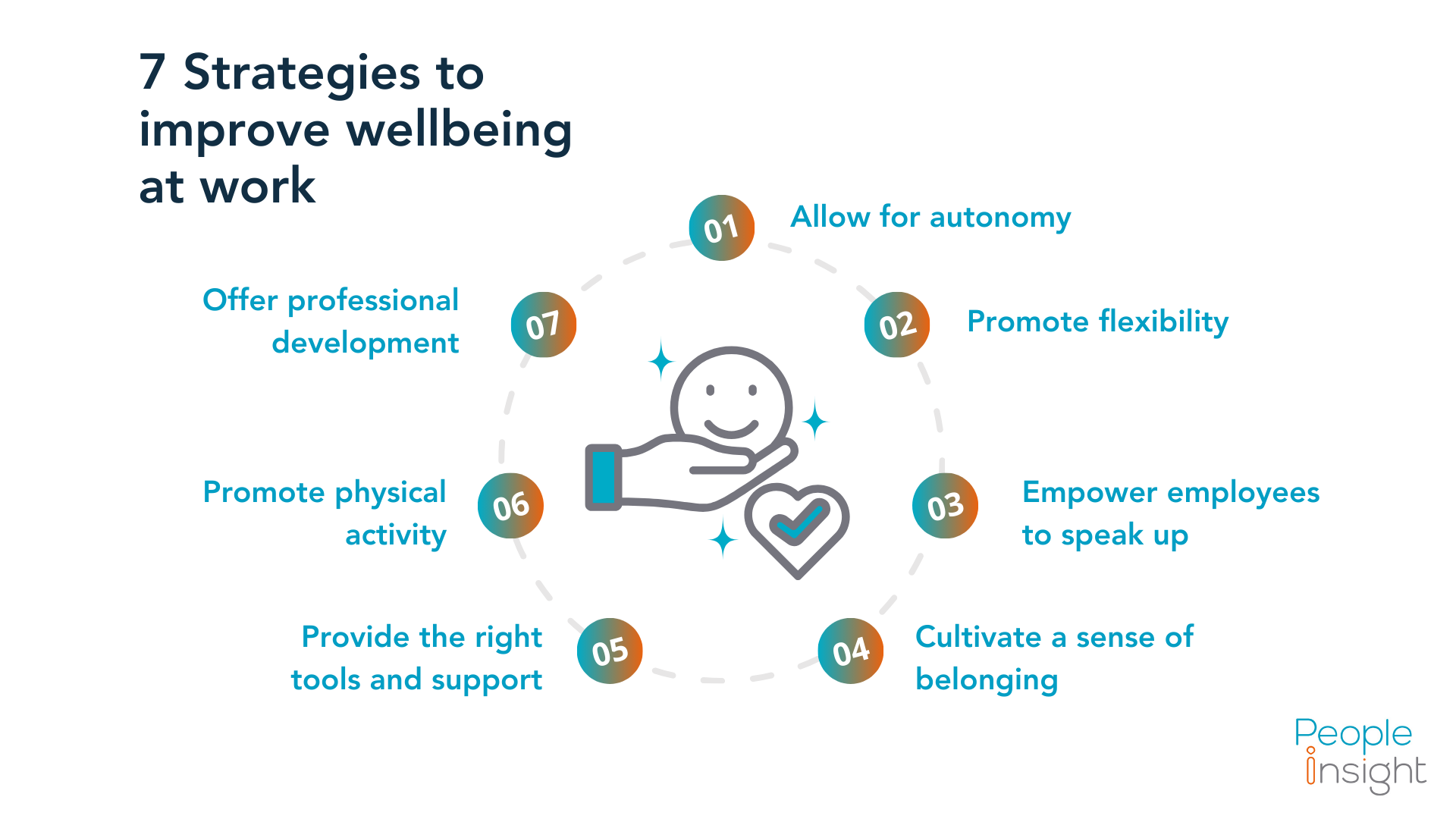
When employees feel their best, they perform at their best. But workplaces that overlook wellbeing often see signs of stress — such as absenteeism, disengagement and burnout — creeping into their teams and leaving their mark. Research shows that poor mental health costs UK employers as much as £51 billion a year, making employee wellbeing a business-critical priority — one that needs acting on today.
A proactive approach to wellbeing at work improves morale, of course, but it also contributes to improved staff retention, productivity and long-term business success. But how do you go about improving levels of wellbeing in the workplace?
Here at People Insight, we’ve put our heads together and outlined seven effective strategies to enhance wellbeing at work, based on our years of HR consultancy experience.
Explore our employee wellbeing guide to bring about authentic change

Giving employees more control over how they complete their work can significantly impact their mental and physical health. Studies indicate that employees with little discretion over their tasks face a higher risk of stress-related health issues, including heart disease. On the other hand, those with more autonomy experience lower stress hormone levels and greater levels of engagement.
Allowing employees the freedom to manage their workload in a way that suits them, while still meeting objectives, can go a long way to boosting levels of wellbeing at work. Encouraging independent decision-making, allowing flexible scheduling and promoting ownership over projects can help achieve this balance.
The great news is, businesses appear to be making great strides in this area, with employees generally reporting high levels of autonomy across sectors. Our 2025 benchmark data shows, for example, that 86% of employees say they have the freedom they need to get on with their work.
Flexible working arrangements are linked to lower stress and higher engagement. Research from O.C. Tanner’s Global Culture Report found that employees with flexibility in when and where they work are 71% more likely to stay with their employer long-term.
While hybrid working is a popular way to introduce this freedom and flexibility, there are other options to consider. Allowing employees to adjust their start and end times, swap shifts more easily or take personal days when needed can make a significant difference in workplace wellbeing.
Related: How to run a company successfully in 2025
Creating an organisational culture where employees feel encouraged to share their opinions can lead to a more positive work environment, improved levels of psychological safety and better overall wellbeing. Employee surveys are a particularly effective way to capture feedback and demonstrate that leadership is listening. However, action is key — following up on survey results with meaningful changes will reinforce trust and engagement.
Our data shows that as of 2025, 67% of employees feel their opinion is actively sought on decisions that affect their work. However, only 59% feel any action will be taken by leadership once their opinions are sought. For those seeking inspiration and help for what to do post-survey, you can check out our guide on post-survey action planning.
Social relationships at work play a significant role when it comes to mental and emotional wellbeing at work. Employees who feel connected to their colleagues report lower psychological distress. A workplace culture that supports friendships and collaboration can help employees feel like they belong, reducing feelings of isolation and stress.
Encourage regular team-building activities, informal social gatherings and collaborative projects to help employees develop meaningful connections. Finding what works best for your organisation is key — some teams may prefer structured activities, while others thrive in a more relaxed setting.
Of course, we can’t discuss belonging at work without discussing diversity and inclusion. Businesses need to make sure everyone is treated equally and fairly, regardless of background, race or any other quality. Currently, we know that 31% of employees don’t feel that everyone at their company is treated fairly or equally — implying that nearly a third of employees simply don’t feel they belong at their place of work.
Lack of adequate resources can increase stress levels and impact performance. Equipping employees with the right tools, from project management software to ergonomic workstations, can improve efficiency, reduce frustration and really enhance a feeling of wellbeing at work.
Beyond physical resources, strong managerial support is essential. Studies show that a manager’s impact on an employee’s mental health is comparable to that of a spouse. Encouraging managers to schedule regular check-ins, provide clear expectations and offer constructive feedback can create a supportive work environment that really enhances wellbeing in the long-term.
Physical activity is closely linked to mental wellbeing. Exercise can reduce stress, increase energy levels and improve overall mood. Encouraging employees to incorporate movement into their day, whether through walking meetings, subsidised gym memberships or in-office wellness initiatives, can lead to better health and productivity.
Joe Wicks, a well-known fitness advocate, has suggested that workplaces introduce ‘movement hours’ to encourage employees to step away from their desks and engage in physical activity. Small, regular movement breaks throughout the day can have a significant impact on wellbeing at work.
Employees who feel they are growing in their careers are more likely to be engaged and motivated. Investing in professional development, whether through training programs, mentorship or skill-building workshops, demonstrates a commitment to employee success. Unfortunately, currently only 57% of employees feel their career development aspirations are being met at work.
A lack of career progression opportunities can contribute to disengagement and increased turnover. Organisations that support ongoing learning and development create a more motivated and resilient workforce, ultimately benefiting both employees and the business.
Prioritising wellbeing at work represents an opportunity for business leaders — healthy, happy workers are an asset, and the value they add only improves over time. Employee surveys, and staff wellbeing surveys in particular, can be powerful tools for identifying areas for improvement and measuring the effectiveness of wellbeing initiatives. By actively listening to employees and addressing their needs, organisations can create a healthier, more productive workplace.
To gain deeper insights into employee wellbeing at your organisation, consider running a staff wellbeing survey. Contact us today to learn how People Insight can help you improve wellbeing at work through data-driven strategies.
